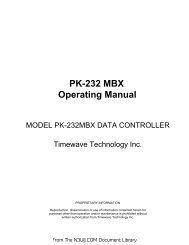DXE-RTR-1 Receive Antenna Interface for Transceivers - N3UJJ
DXE-RTR-1 Receive Antenna Interface for Transceivers - N3UJJ
DXE-RTR-1 Receive Antenna Interface for Transceivers - N3UJJ
- No tags were found...
You also want an ePaper? Increase the reach of your titles
YUMPU automatically turns print PDFs into web optimized ePapers that Google loves.
<strong>DXE</strong>-RSC-2 - Two-port Splitter/CombinerUse the DX Engineering RSC-2 to combine two receiving antennas to <strong>for</strong>m an array or to split the signalfrom an antenna to feed two receivers. The RCS-2 reduces problems and per<strong>for</strong>mance shortfalls caused byimpedance errors in less-than-perfect antenna systems.• Metal housing <strong>for</strong> superior shielding and longer life• High quality components• Internal spark gaps and large ground planes <strong>for</strong> improved lightning protection• Reliable CATV F connectors standard• Broad, 0.3 to 30 MHz operating range with 75 Ω systems• Economical solution to potential impedance errors<strong>DXE</strong>-RFCC-1 - <strong>Receive</strong> Feedline Current Choke, 50 to 75 Ohm 300 kHz to 30 MHzIf you wish to reduce feedline radiation and improve reception, a Feedline Current Choke is recommended if your SWR is alreadylow. Adding a DX Engineering Feedline Current Choke at the point where the feedline exits the area of the antenna will substantiallyreduce unwanted feedline radiation or reception without the need <strong>for</strong> improved station grounding.The advantages of using an FCC:• Prevents unwanted RFI by eliminating feedline current and radiation• All power goes to the antenna, improving efficiency• Reduces noise or unwanted signals picked-up by the feedline• Overcome a less than optimal ground systemThe DX Engineering RFCC-1 receive feedline common-mode choke is the most effective solutionto common-mode noise or unwanted signal ingress available to date. The DX Engineering RFCCprovides thousands of ohms isolation between the input and output coaxial shield connections while passing desired signals,including dc or low frequency ac control signals. The RFCC has extremely high isolation impedance which effectively blockscommon-mode noise or unwanted signals, even in the presence of very poor grounding. Low noise receive antennas are traditionallylocated away from electrical wiring and other noise sources. Un<strong>for</strong>tunately, noise and other unwanted signals have a direct path toyour low-noise antenna through the feedline shield connections between the station equipment and antenna. Unwanted signals canalso energize the outside of the feedline shield, and this undesired signal energy can be conducted directly to the receiving antenna.This can reduce antenna directivity. Unless you have a perfect zero-resistance RF ground at the antenna, some of the common-modenoise or unwanted signals from the feedline shield will make it into the antenna. The RFCC is effective from 300 kHz to 30 MHz. Itcomes with standard CATV type “F” female connectors, although it can be used in any 50 to 75 ohm receiving system. The RFCC isa passive device, there<strong>for</strong>e requires no power to operateRG-8/U Foam Coax AssembliesThese DX Engineering cable assemblies use high quality Belden 8214/RG-8/U Foam dielectric coaxial cable andinclude Silver Teflon PL-259 (UHF) connectors installed at each end. RG-8/U cable is protected by a PVC jacketand is normally recommended <strong>for</strong> indoor applications - or protected areas where ultraviolet contamination isunlikely to occur. When comparison shopping, note that RG-8/U is no longer a government MIL-spec cable -leaving it open to interpretation by many manufacturers. When in doubt, use RG-213/U with a non-contaminatingPVC jacket <strong>for</strong> longest life in most outdoor applications. The coax has a flexible 11 gauge stranded copper center, foamed Polydielectric, 97% coverage bare copper shield and a black PVC jacket. The PL-259 connector is silver plated with a silver plated centerconductor. Connectors are soldered rather than crimped and an adhesive lined shrink tubing is used to <strong>for</strong>m a weather-resistant bondbetween the connector body and the coax. Each assembly is then 100% Hi-Pot tested to guarantee a quality cable assembly you cancount on.Custom Lengths Available, Call DX Engineering <strong>for</strong> Details<strong>DXE</strong> Part #Part Name<strong>DXE</strong>-CBC-008U002 Coax Cable, RG-8/U, UHF connectors, 2 feet <strong>for</strong> BTV DCF kit<strong>DXE</strong>-CBC-008U003 Coax Cable, RG-8/U, UHF connectors, 3 feet<strong>DXE</strong>-CBC-008U006 Coax Cable, RG-8/U, UHF connectors, 6 feet<strong>DXE</strong>-CBC-008U012 Coax Cable, RG-8/U, UHF connectors, 12 feet30From The <strong>N3UJJ</strong>.COM Document Library
















